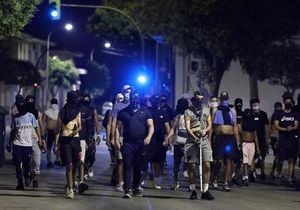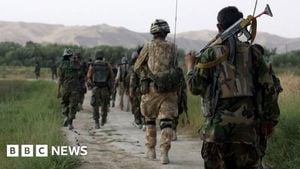On June 23, 2025, US President Donald Trump announced a "complete and total" ceasefire agreement between Iran and Israel, potentially bringing an end to what he called "THE 12 DAY WAR." This announcement came just hours after Iran launched missiles targeting the Al Udeid Air Base in Qatar, which houses American troops, in retaliation for US strikes on Iranian nuclear facilities over the weekend.
Trump’s declaration, made via social media, congratulated both nations for their "Stamina, Courage, and Intelligence" in ending a conflict that threatened to engulf the Middle East. He wrote, "This is a War that could have gone on for years, and destroyed the entire Middle East, but it didn’t, and never will! God bless Israel, God bless Iran, God bless the Middle East, God bless the United States of America, and GOD BLESS THE WORLD!" However, neither Iran nor Israel had officially confirmed the ceasefire more than an hour after Trump’s announcement.
Al Jazeera correspondent Tohid Asadi, reporting from Tehran, noted that explosions and activation of air defense systems continued shortly after the announcement, indicating ongoing strikes and retaliations on the ground. Middle East analyst Omar Rahman expressed skepticism about the ceasefire's durability, highlighting missing details such as whether formal negotiations would follow. Rahman also criticized Trump’s previous handling of the conflict, pointing out a history of "deception" towards Israel and the shifting US stance—Trump had initially promised diplomacy hours before Israel launched its attack on Iran.
The conflict escalated dramatically on June 13, when Israel launched massive preemptive strikes against Iranian nuclear and missile programs, killing hundreds, including several Iranian generals. Iran responded with hundreds of missiles fired into Israel, causing widespread destruction. On June 21, Trump authorized US airstrikes on three Iranian nuclear facilities, a high-risk move that intensified hostilities.
In response, Iran launched a missile attack on the US base in Qatar on June 23. US defense officials reported that all Iranian missiles were intercepted with no casualties or damage. Trump dismissed the retaliation as "very weak," suggesting the US would not respond further. Scholar Liqaa Maki of the Al Jazeera Media Institute noted that while Iran’s nuclear program suffered damage, the country still retains significant quantities of highly enriched uranium and nuclear expertise, potentially allowing it to resume nuclear activities within two to three years without inspections.
Behind the scenes, intense diplomatic efforts unfolded. Trump communicated directly with Israeli Prime Minister Benjamin Netanyahu, while Vice President JD Vance, Secretary of State and National Security Adviser Marco Rubio, and Middle East Envoy Steve Witkoff engaged with Iranian officials through direct and indirect channels. Qatar played a pivotal intermediary role, with Emir Tamim bin Hamad bin Khalifa Al Thani facilitating discussions. These efforts culminated in the ceasefire announcement, with Israel agreeing to halt operations on the condition that Iran cease its attacks, and Iran accepting those terms.
Iran’s Foreign Minister Abbas Araghchi confirmed that Iranian military operations against Israel continued until 4 a.m. Tehran time on June 24, after which Iran would halt its response if Israel stopped its strikes. He wrote, "The military operations of our powerful Armed Forces to punish Israel for its aggression continued until the very last minute, at 4 a.m." Iranian state media later announced that a ceasefire had been "imposed on the enemy" following their military response to US aggression.
Despite the ceasefire, sirens sounded across northern Israel on June 24, more than two hours after the ceasefire began, as Israeli forces detected missiles launched from Iran. The Israeli military reported six waves of missile attacks, resulting in four deaths in Beersheba, according to Israel’s national ambulance service. Meanwhile, Iran reported nine fatalities and 33 injuries in a "terrorist attack" in the northern province of Gilan, with reports indicating the killing of nuclear scientist Mohammadreza Sediqi in an Israeli strike prior to the ceasefire.
Israeli Prime Minister Netanyahu confirmed Israel’s agreement to the ceasefire, stating that Israel had achieved its goal of removing Iran’s nuclear and ballistic missile threats but warned of a forceful response to any violations. Trump urged both sides not to violate the ceasefire, writing, "THE CEASEFIRE IS NOW IN EFFECT. PLEASE DO NOT VIOLATE IT!" The White House credited the ceasefire to the US strikes on Iranian nuclear facilities and ongoing diplomatic negotiations.
Trump’s weekend attack was described as a high-risk maneuver that may have paid off, drawing parallels with the January 2020 killing of Iranian Revolutionary Guard leader Qasem Soleimani, which led to Iranian missile attacks on US bases in Iraq without further escalation. The Iranian missile attack on the US base in Qatar reportedly matched the number of bombs dropped by US warplanes during the weekend strikes, and Iran provided advance notice to Qatar, suggesting a desire for proportionality rather than escalation.
Throughout the conflict, Israel expanded its targets beyond nuclear and missile sites to include command centers, security forces, and Evin prison—a notorious facility housing political prisoners. Israeli strikes damaged critical infrastructure and military assets, including six airports, runways, underground bunkers, and older fighter jets. Although regime change was not officially an objective, Israeli officials encouraged Iranians to rise against their government, a strategy met with skepticism by analysts who noted a lack of protests during the strikes.
Diplomatic efforts to revive nuclear talks persisted throughout the conflict. The US communicated clear terms: no uranium enrichment by Iran, while Iran insisted on its right to enrich uranium. Interlocutors exchanged messages, and plans for a meeting between Trump and the Iranian president in Turkey were considered but did not materialize. Following the ceasefire, US officials expressed hope that the truce would create space for renewed negotiations.
Markets responded positively to the ceasefire news, with US stock futures rising and crude oil prices falling amid reduced fears of supply disruption. However, the fragile peace remains uncertain, with both sides wary of potential violations. The world watches closely to see if this ceasefire can hold and whether it marks the beginning of a lasting peace in a region long plagued by conflict.




